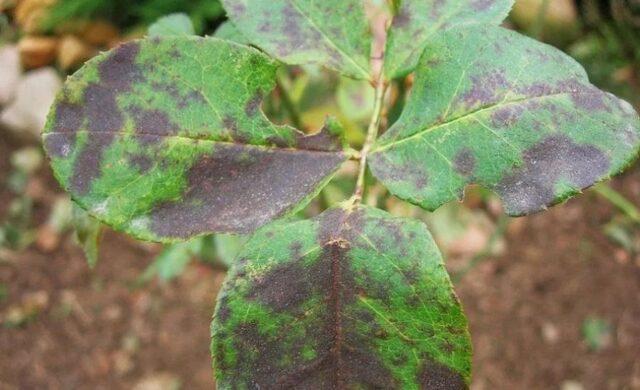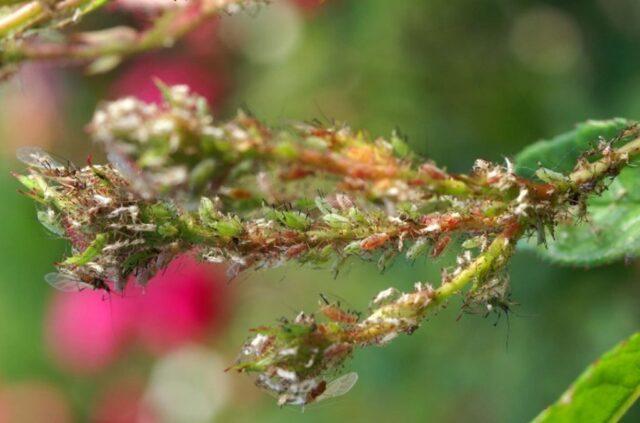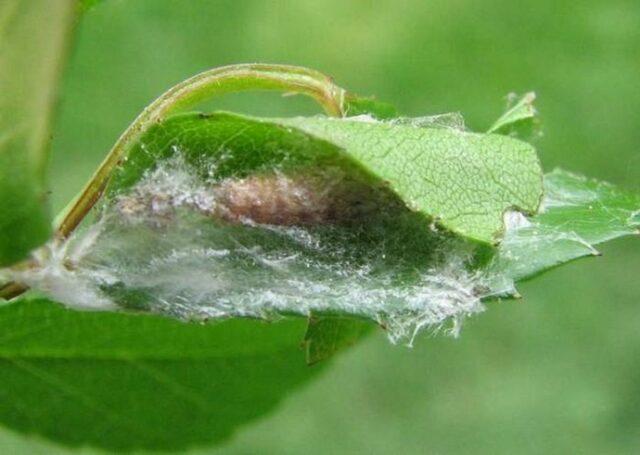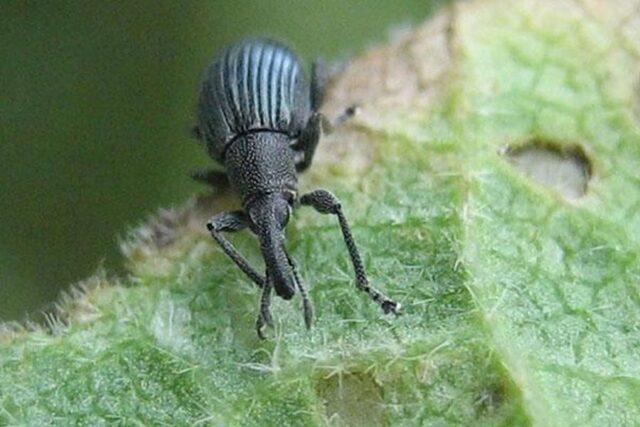Content
- 1 What does the description of a decorative rosehip look like?
- 2 Types and varieties of decorative rose hips
- 3 The benefits of a large decorative rosehip
- 4 Planting and caring for a decorative rosehip
- 5 Why decorative rose hips do not bloom
- 6 How to propagate a decorative rosehip
- 7 What plants is combined with
- 8 Is it possible to brew, are there fruits of a decorative rosehip
- 9 Conclusion
The decorative rose hip combines several plant varieties under a common name. Its medicinal value is not very great, but such a shrub looks very attractive in the garden.
What does the description of a decorative rosehip look like?
The appearance of a decorative rose hip depends on the specific plant species. But there are also common features. Shrubs of this type have vertical or creeping stems 5-10 m long, the shoots are covered with crescent or straight thorns, located mainly in the lower part.
Ornamental rose hips have petioled leaves, unpaired of 5-9 or more leaflets. The plates are smooth in structure, sometimes with slight pubescence, and are usually elliptical or obovate in shape.
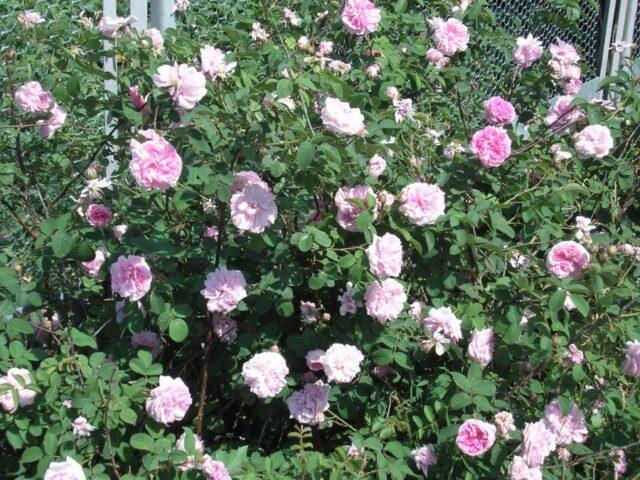
Ornamental rose hips bloom from early June to late summer.
The buds of decorative rose hips can be collected in umbellate, paniculate or aciniform inflorescences, the shade of the petals varies from white to pink and deep red. There are also yellow varieties.
Closer to autumn, the ornamental plant bears many-root fruits with yellow or brown seeds, surrounded by fleshy hypanthia with hairs. At the rift, the rose hips are usually red or orange and have a sour-sweet taste.
How to distinguish a medicinal rosehip from a decorative one
Both medicinal and decorative rose hips are represented by numerous species and varieties. At the same time, externally, the shrubs are very similar to each other in outlines, structure, vegetative characteristics and the shape of the fruits.
You can distinguish a medicinal rosehip from a decorative one by sepals. In vitamin medicinal varieties, they are directed forward, while in ordinary ones they are bent back and "lie" on the fruits.
Types and varieties of decorative rose hips
It is customary to distinguish several main varieties of decorative rose hips. The differences between them are in size, shade of buds and timing of flowering.
French
Rosehip French, or Gallic, is a shrub that is widespread in southern Europe, the Crimea and western Russia. It has a developed root system capable of producing shoots on the sides of the main plant. Abundantly covered with large and small curved spines and straight needles.
The inflorescences of the French rosehip are large, located at the ends of the shoots, the shade can be pink, bright red or burgundy. The species is characterized by large rich green leaves with villi on the underside and large sepals with lateral feathers.

French decorative rose hips usually do not exceed 1 m in height and branch slightly
May
May, or cinnamon, rosehip is a widespread shrub in central Russia.Differs in high unpretentiousness and winter hardiness, has good immunity to pests and fungi.
In height, the shrub can rise up to 3 m. The inflorescences of the species are pale pink, medium in size, the shoots are covered with curved thorns, and thin straight needles are located next to the buds. Fruits are spherical or slightly elongated, appear on the branches in August and do not fall off for a long time.
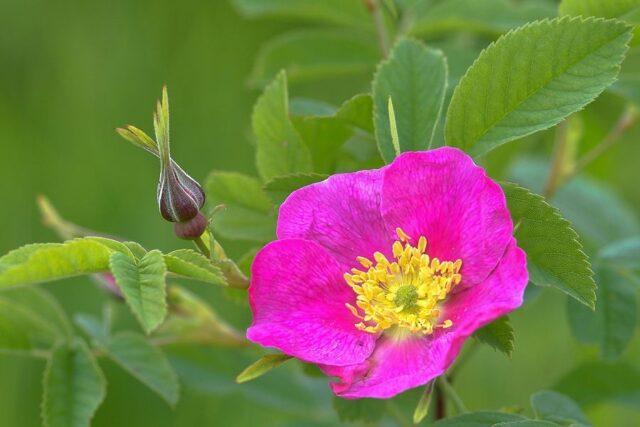
In accordance with the name, the May rose hips bloom in late spring, but only in warm regions.
Parkovy
The park rose, which is also often called the park rose, has a dense crown and bright flowering. Plant buds can be white, yellow, orange, red and even purple, depending on the particular cultivar. As a rule, the shrub produces double flowers with 100-150 petals. It usually rises above the ground by 1.5 m.

Park rose hips bloom at the end of May and remain decorative for about a month.
The benefits of a large decorative rosehip
The difference between a decorative rosehip and a medicinal one is, among other things, in the reduced benefits of fruits, flowers and leaves. Despite this, vitamins are still present in the parts of the plant and have a beneficial effect on the body, albeit less pronounced.
When consumed according to proven recipes, the plant:
- helps to strengthen the immune system and helps to quickly get rid of colds;
- accelerates digestion and improves appetite;
- positively affects the state of blood vessels and normalizes the heart rate;
- evens out blood pressure;
- helps to cleanse the liver of toxins and toxins;
- normalizes the nervous system and fights stress;
- improves sleep;
- relieves inflammation and promotes healing of mucous membranes;
- has a beneficial effect on the functioning of the kidneys and urinary system.
Due to the high iron content, the plant is used in folk medicine for the prevention and treatment of anemia.
Planting and caring for a decorative rosehip
A photo and description of a decorative rose hip presents it as a plant that is undemanding to growing conditions. When planting and in the process of further care, it is enough to follow the basic rules.
Site and soil requirements
Decorative rose hips grow well in light and semi-shaded areas. But it is best to plant it in higher elevations in the sun. This will ensure an abundant and spectacular bloom. The plant has low soil requirements - the culture prefers slightly acidic or loamy soils.

Groundwater should not pass near the rosehip
Shortly before planting a shrub, the soil on the site can be improved. The selected place is dug up and brought in by 1 m2 soil 25 g of potassium salt, 50 g of superphosphate and 5-7 kg of compost. Sour soil should be treated with slaked lime.
How to plant correctly
Planting of decorative rose hips is carried out in the spring before bud break or in the fall, in October and early November. Saplings are placed 1.5 m from each other, when forming a hedge they leave 50-80 cm between the bushes.
The landing algorithm looks like this:
- In advance, a hole is dug on the site about 50 cm in depth and width. The hole is half-filled with a mixture of garden soil, humus and mineral fertilizers.
- A decorative rosehip sapling is slightly trimmed - up to 25 cm in total length, while the size of the roots should be about 10 cm.
- The underground part is briefly immersed in a mash made of clay or peat and manure.
- A decorative rose hip is placed in the dug hole and the roots are straightened.
- The plant is covered with the remnants of the soil mixture, carefully tamped the soil and watered.
Immediately after planting, it is recommended to mulch the shrub with peat, sawdust or other material. This will slow down the evaporation of moisture.
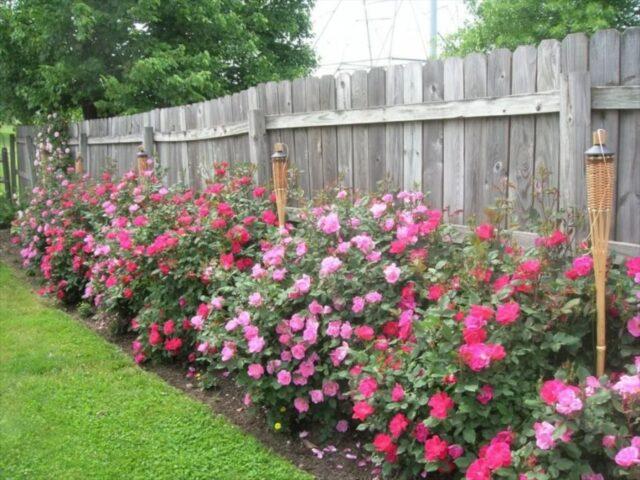
Decorative rose hips are often planted next to facades and fences to limit overgrowth.
When and how to fertilize
When growing decorative rose hips, special attention should be paid to top dressing. Usually, fertilization of the plant begins from the second year of life. Before and after flowering, complex mixtures with a high nitrogen content are introduced into the soil. In August, decorative rose hips can be fed with potassium and phosphorus. The minerals will help the plant better prepare for winter and will also provide abundant fruit on the branches.
Once a year, the shrub can be fertilized with compost or humus. It is recommended to apply organic matter in the fall, scattering it in a thick layer in the near-trunk circle. In this case, top dressing will not only deliver valuable substances to the roots, but also warm the plant before the arrival of winter.
How to prune a decorative rose hip
Decorative rose hips grow quickly and require regular pruning. The hedge or art group is trimmed as needed according to the chosen shape. A lonely growing shrub is pruned in early spring for sanitary purposes - all weak damaged branches are removed and strong shoots are shortened by 20 cm.
To keep the plant in shape longer, it can be pinched at a height of about 70 cm. This further stimulates the development of lateral processes and flower buds.
It is recommended to rejuvenate the decorative rosehip every few years. All branches older than five years are removed from the shrub and only young shoots are left, actively participating in flowering and fruiting.
Diseases and pests
Like any crop, decorative rose hips can suffer from diseases and pests. His immunity is quite high, but some fungi are still dangerous. Among them:
- rust - with this disease, a dense orange bloom appears on the stems, and rounded red spots appear on the leaves;
Rust impairs the decorative properties of the plant and interferes with flowering
- black spot - a fungal disease can be recognized by dark spots on the leaves, which quickly turn into necrotic areas and through holes;
Under the influence of black spot, flower branches dry out
- powdery mildew - one of the most common ailments forms a whitish coating on the leaves of a plant and leads to their drying out.
With powdery mildew, the buds dry out before they have time to open
Bordeaux liquid and copper sulfate, as well as the preparations Fundazol and Skor, help well for most fungal ailments. Spraying in accordance with the instructions is necessary several times from spring to autumn. In this case, it is important to start treatment when the first symptoms appear and immediately remove all affected parts of the plant.
Decorative rose hips in the garden can suffer from pests. Especially dangerous for him are:
- aphids - the parasite feeds on plant sap and multiplies very quickly in huge colonies;
Aphids are carriers of viral and fungal infections for plants.
- leaf roll - the insect lays the larvae on the plant, and the hatched caterpillars devour leaves and flower buds;
A striking sign of the leaf roll is the deformation of the leaves and the cobweb on them.
- leaf beetle weevil - the insect feeds on young leaves, leads to drying and slow extinction of the plant.
Leaf beetle appears on decorative rose hips in April and May
Pest control is carried out using soap and ash solutions with moderate damage. If there are a lot of insects, then it is better to use chemical preparations - Inta-Vir, Aktellik, Fufanon and others.
Preparing for winter
Decorative rose hips are highly frost-resistant and usually do not require careful covering for the winter.Before the onset of cold weather, it is recommended only to mulch the near-trunk circle with compost, rotted manure or peat, and throw straw or spruce branches on top.
Young bushes are more sensitive to frost. For the winter, they can be additionally wrapped in burlap or other insulating material. But with the onset of the thaw, it will need to be removed, otherwise the shoots will begin to flutter.
Why decorative rose hips do not bloom
Decorative rose hips in the garden may not bloom for several reasons:
- Abundance of root growth. The plant spends all its energy on the development of vegetative shoots, and there are simply no resources left for tying buds.
- Lack of moisture. Rosehip withstands drought well and does not require frequent watering. But if the spring came out completely without rain, then it is necessary to bring a couple of buckets of water under the bush once a week, otherwise the plant will not bloom.
- Lack or excess of fertilizers. Decorative rose hips may not bloom on too poor soil in the absence of fertilizing. An excess of fertilizers also affects it badly - especially carefully, nitrogen must be added to the soil, which is responsible for the growth of green mass.
Lack of flowering can also be due to fungal or pest infestation. If the crop is not budding, the leaves and stems should be carefully inspected for insects or suspicious spots.

Decorative rose hips bloom poorly or do not bud at all with a lack of sunlight
How to propagate a decorative rosehip
Decorative rose hips on the site are propagated in several ways:
- Seeds - the material is harvested from fruits in August and sown directly into open ground for natural winter stratification.
- Layers - a healthy lower branch of the plant can be easily bent to the ground and fixed until roots appear on the buried part of the shoot.
- By dividing - this method is used to rejuvenate and thin out old specimens, in the process, the shrub is dug up and simply cut into 2-3 parts along the rhizome.
Vegetative methods are considered more convenient. They allow you to grow a decorative rosehip faster and wait for flowering in the second year.
Reproduction of decorative rose hips by cuttings
One of the best ways to grow a plant on a site is green cuttings. The algorithm is as follows:
- In late May or early June, young apical shoots about 10 cm long are cut from the shrub and the lower leaf plates are removed.
- The sprouts are placed in water and left in a lighted place at room temperature until the roots appear.
- Fortified cuttings are transplanted into peat pots with nutritious soil or immediately taken out to a temporary bed.
Until autumn, the decorative rosehip is regularly watered, and then insulated for the winter. With the onset of spring, the sprouts can be transplanted to a permanent place.
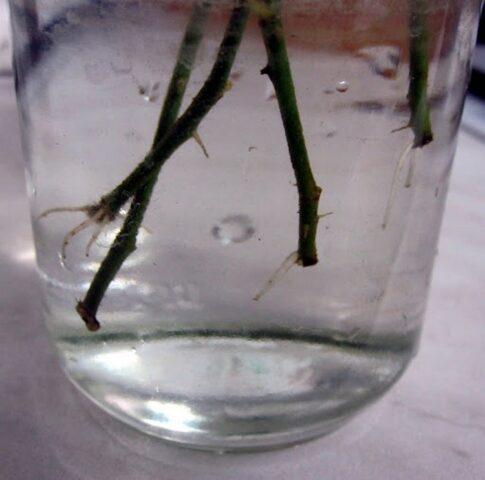
For quick rooting, growth stimulants are added to the cuttings water
What plants is combined with
You can plant a decorative rosehip in the garden with almost any shrubs and perennials that have similar requirements for soil and lighting. Bells, asters, phlox, geranium and lavender become good neighbors for culture.
It should be borne in mind that the rose hips suppress other plants. When creating an art group, you should often prune the shrub and remove the root growth.
Is it possible to brew, are there fruits of a decorative rosehip
The berries of the decorative rose hips contain fewer vitamins and minerals than the fruits of medicinal varieties. But they are nevertheless suitable for eating and brewing drinks. On the basis of the fruit, you can prepare decoctions, infusions and teas with a pleasant aroma and strengthening properties.
It is also not forbidden to eat fresh berries of the decorative rose hips.But it should be borne in mind that their flesh is dryish and hairy, and the taste has a pronounced sourness. Such fruits do not possess dessert qualities.
Conclusion
The decorative rosehip is actively cultivated as a garden plant. The shrub is distinguished by beautiful flowering and unpretentiousness. The fruits of the culture have medicinal value, although they do not bring the same health benefits as the berries of medicinal rose hips.

